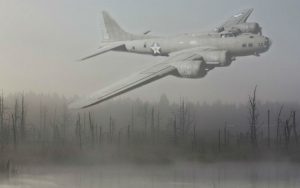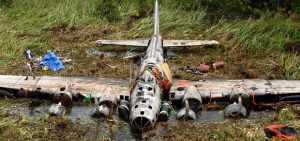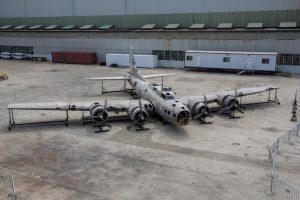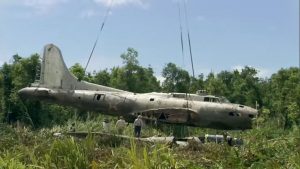
 The Swamp Ghost began its very short career on December 6, 1941, one day before the Japanese attacked Pearl Harbor. The Swamp Ghost started out as B-17 Flying Fortress, 41-2446 (which is not a tail number, and indicated that the plane was a new purchase) and under that number it was delivered to the United States Army Air Forces (USAAF). Eleven days later, the bomber departed California for Hickam Field in Pearl Harbor, Hawaii. The plane and her crew were based at Wheeler Field in Wahiawa for a very short time, and flew patrol missions for the Navy until February 1942, when the Japanese Troops invaded Rabaul on New Britain and established a base. Of course, this was a threat to the rest of New Guinea and Australia. In response to the invasion, 41-2446 was ordered to Garbutt Field, Townsville, in Queensland, Australia. Swamp Ghost’s crew included Pilot Captain Frederick C. “Fred” Eaton, Co-Pilot Captain Henry M. “Hotfoot” Harlow, Navigator 1st Lieutenant George B. Munroe Jr, Bombardier Sergeant J.J. Trelia, Flight Engineer Technical Sergeant Clarence A. LeMieux, Radio Operator/Gunner Sergeant Howard A. Sorensen, Waist Gunner Sergeant William E. Schwartz, Waist Gunner Technical Sergeant Russell Crawford, and Tail Gunner Staff Sergeant John V. Hall. The only crew change would be Sergeant Richard Oliver, who replaced Bombardier Trelia after he became ill.
The Swamp Ghost began its very short career on December 6, 1941, one day before the Japanese attacked Pearl Harbor. The Swamp Ghost started out as B-17 Flying Fortress, 41-2446 (which is not a tail number, and indicated that the plane was a new purchase) and under that number it was delivered to the United States Army Air Forces (USAAF). Eleven days later, the bomber departed California for Hickam Field in Pearl Harbor, Hawaii. The plane and her crew were based at Wheeler Field in Wahiawa for a very short time, and flew patrol missions for the Navy until February 1942, when the Japanese Troops invaded Rabaul on New Britain and established a base. Of course, this was a threat to the rest of New Guinea and Australia. In response to the invasion, 41-2446 was ordered to Garbutt Field, Townsville, in Queensland, Australia. Swamp Ghost’s crew included Pilot Captain Frederick C. “Fred” Eaton, Co-Pilot Captain Henry M. “Hotfoot” Harlow, Navigator 1st Lieutenant George B. Munroe Jr, Bombardier Sergeant J.J. Trelia, Flight Engineer Technical Sergeant Clarence A. LeMieux, Radio Operator/Gunner Sergeant Howard A. Sorensen, Waist Gunner Sergeant William E. Schwartz, Waist Gunner Technical Sergeant Russell Crawford, and Tail Gunner Staff Sergeant John V. Hall. The only crew change would be Sergeant Richard Oliver, who replaced Bombardier Trelia after he became ill.
Because of the B-17’s long flying range, the Japanese control of Wake Island and Guam, and the Vichy government’s armistice with the Nazi government, 41-2446 island hopped nearly 5,700 detour miles to get to Townsville. They didn’t want to take a chance on running into enemy fighters, if they could help it. On February 22, 1942, nine B-17Es of the 19th Bombing Group were scheduled to take off for Rabaul. Unfortunately, this mission seemed doomed from the start, as nothing would go quite as planned. Out of the nine aircraft, four had to completely abort the mission due to mechanical problems. To further complicate matters, bad weather conditions made it difficult to see up in the air for those who were able to takeoff. Finally, poor visibility separated the five remaining in flight.
I would like to say that was all the problems they ran into, but there’s more. When 41-2446 was to drop its payload, the bomb bay malfunctioned. The crew had to go around for a second pass, where they managed a clear drop over their target. The Japanese were working hard to make this mission fail too. Japanese fire was intense and a flak round managed to punch a hole through the starboard wing of 41-2556. Fortunately for the crew, the wing didn’t detonate. While the crew hoped to make it to Fort Moresby, they were low on fuel. The dog-fight, had seen to that. They would have to land in New Guinea.
Captain Fred Eaton thought he was setting down the bomber in a wheat field, however, they actually landed wheels-up in the middle of Agaiambo swamp. The only good news in this horrific failure of a mission was that the crew was unscathed, except for one with minor cuts and scrapes. Now, they still had to get out of the swamp. It took two days of hacking their way through the razor-sharp kunai grass for the men to reach dry land. They ran into some locals who were chopping wood. The locals took them, horribly bitten by mosquitos and infected with malaria, to their village. After a night of rest, they traveled downriver in canoes, where they were handed over to an Australian magistrate, and eventually arrived at Port Moresby on April 1…thirty six days after their crash. After a week in the hospital, the men returned to combat, but their plane did not. After 41-2446’s crash, Captain Fred Eaton flew 60 more missions. Whenever these missions would take him over the crash site, he would circle it and tell his new crewmembers the story of what happened. I suppose it was therapeutic to re-live the amazing escape from the Agaiambo swamp. This was where the plane’s legend was born. After Eaton returned home, 41-2446 slipped from the public eye for nearly three decades.
Then, in 1972, some Australian soldiers happened upon the crash. After spotting the wreckage from a helicopter, they landed on the aircraft’s wing and found the plane semi-submerged, and strangely intact. The machine guns were in place, and even the coffee thermoses were intact. They nicknamed the plane, Swamp Ghost, and the name stuck. Thanks to warbird collector Charles Darby who included dozens of photographs in his book, Pacific Aircraft Wrecks, word spread in 1979 . Once the fad of recovering World War II aircraft really took off. Trekkers hiked into the site and began stripping the aircraft for keepsakes and sellable items. Despite the stripping, the aircraft structure itself remained remarkably intact, until it was removed from the swamp.
Alfred Hagen, a pilot and commercial builder from Pennsylvania, set his sights on Swamp Ghost and wanted to take it free it from the disintegration of the swamp. In November 2005, he obtained an export permit for the 
 B-17 for $100,000. For four weeks they labored over the aircraft, dismantling it in order to ship it out of the country. The controversy over its removal halted the cargo before it could be shipped to the United States. Eventually, it was cleared for import and by February 2010 it arrived at the Pacific Aviation Museum at Pearl Harbor for display.
B-17 for $100,000. For four weeks they labored over the aircraft, dismantling it in order to ship it out of the country. The controversy over its removal halted the cargo before it could be shipped to the United States. Eventually, it was cleared for import and by February 2010 it arrived at the Pacific Aviation Museum at Pearl Harbor for display.


Leave a Reply